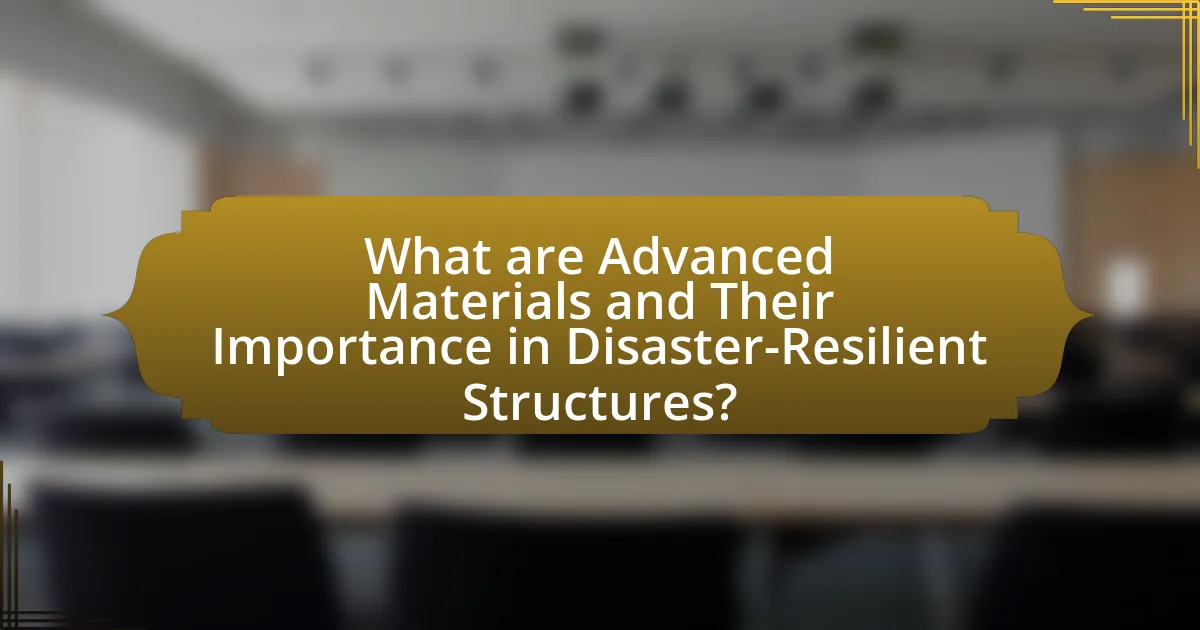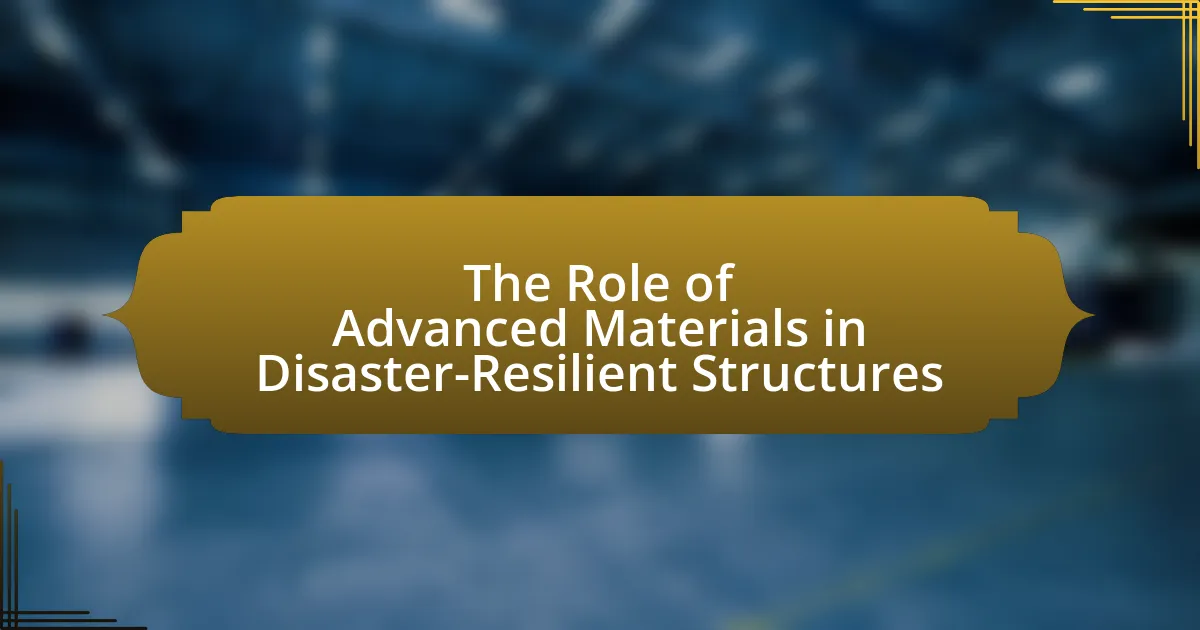Advanced materials are innovative substances designed to enhance the strength, durability, and resilience of structures, particularly in disaster-prone areas. This article explores the significance of advanced materials, such as fiber-reinforced polymers and high-performance concrete, in creating disaster-resilient structures capable of withstanding extreme environmental conditions like earthquakes, floods, and hurricanes. It examines the specific properties that make these materials suitable for enhancing structural performance, their advantages over traditional materials, and the challenges associated with their implementation, including cost and regulatory compliance. Additionally, the article highlights best practices for integrating advanced materials into construction and the importance of collaboration among architects and engineers in material selection.

What are Advanced Materials and Their Importance in Disaster-Resilient Structures?
Advanced materials are innovative substances engineered to possess superior properties, such as enhanced strength, durability, and resistance to environmental factors. Their importance in disaster-resilient structures lies in their ability to withstand extreme conditions, such as earthquakes, floods, and hurricanes, thereby minimizing structural damage and ensuring safety. For instance, materials like fiber-reinforced polymers and high-performance concrete have been shown to significantly improve the resilience of buildings against seismic forces, as evidenced by studies indicating that structures utilizing these materials can endure greater stress and deformation without failure. This capability not only protects human life but also reduces economic losses associated with disaster recovery and rebuilding efforts.
How do advanced materials contribute to the resilience of structures during disasters?
Advanced materials enhance the resilience of structures during disasters by providing superior strength, flexibility, and durability. These materials, such as fiber-reinforced polymers and high-performance concrete, can absorb and dissipate energy from impacts, reducing structural damage. For instance, research indicates that structures utilizing advanced composites can withstand seismic forces better than traditional materials, leading to a 30% reduction in damage during earthquakes. Additionally, advanced materials often exhibit improved resistance to environmental factors like corrosion and extreme temperatures, further extending the lifespan and safety of structures in disaster scenarios.
What specific properties make advanced materials suitable for disaster resilience?
Advanced materials are suitable for disaster resilience due to their high strength-to-weight ratio, durability, and adaptability to extreme conditions. These materials, such as fiber-reinforced composites and high-performance concrete, exhibit enhanced mechanical properties that allow structures to withstand natural disasters like earthquakes, floods, and hurricanes. For instance, fiber-reinforced polymers can absorb significant energy during seismic events, reducing structural damage. Additionally, advanced materials often possess superior corrosion resistance, which prolongs the lifespan of structures exposed to harsh environmental conditions. Studies have shown that buildings constructed with these materials can achieve higher safety ratings and lower repair costs post-disaster, validating their effectiveness in enhancing resilience.
How do advanced materials compare to traditional materials in disaster scenarios?
Advanced materials outperform traditional materials in disaster scenarios due to their enhanced strength, durability, and adaptability. For instance, materials like carbon fiber composites and high-performance concrete exhibit superior resistance to extreme conditions such as earthquakes, floods, and fires compared to conventional materials like steel and standard concrete. Research indicates that structures built with advanced materials can withstand forces up to 50% greater than those made with traditional materials, significantly reducing the risk of catastrophic failure during disasters. This capability is crucial for ensuring the safety and longevity of infrastructure in vulnerable regions.
What types of advanced materials are commonly used in disaster-resilient structures?
Advanced materials commonly used in disaster-resilient structures include high-performance concrete, fiber-reinforced polymers, and shape-memory alloys. High-performance concrete offers enhanced strength and durability, making it suitable for withstanding extreme weather and seismic events. Fiber-reinforced polymers provide lightweight yet strong alternatives to traditional materials, improving structural resilience against impacts and corrosion. Shape-memory alloys can return to their original shape after deformation, allowing structures to absorb and dissipate energy during disasters. These materials have been validated through various studies, demonstrating their effectiveness in enhancing the safety and longevity of buildings in disaster-prone areas.
What are the characteristics of fiber-reinforced polymers?
Fiber-reinforced polymers (FRPs) are composite materials characterized by their high strength-to-weight ratio, corrosion resistance, and flexibility. These materials consist of a polymer matrix reinforced with fibers, typically made from glass, carbon, or aramid, which significantly enhance their mechanical properties. For instance, carbon fiber-reinforced polymers exhibit tensile strengths exceeding 500 MPa, making them suitable for structural applications in disaster-resilient designs. Additionally, FRPs are lightweight, often 60% lighter than steel, which facilitates easier handling and installation in construction. Their resistance to environmental degradation, including moisture and chemicals, further ensures durability in harsh conditions, making them ideal for structures that must withstand extreme events.
How do smart materials enhance structural performance during disasters?
Smart materials enhance structural performance during disasters by adapting their properties in response to environmental changes, thereby improving resilience and safety. For instance, shape memory alloys can return to their original form after deformation, which helps structures maintain integrity during seismic events. Additionally, piezoelectric materials can generate electrical energy from mechanical stress, enabling real-time monitoring of structural health. Research indicates that structures incorporating smart materials can experience up to 30% less damage during earthquakes compared to traditional materials, demonstrating their effectiveness in disaster scenarios.

How do Advanced Materials Enhance Structural Performance in Disasters?
Advanced materials enhance structural performance in disasters by providing increased strength, flexibility, and durability, which are critical for withstanding extreme conditions. For instance, materials such as fiber-reinforced polymers and high-performance concrete can absorb and dissipate energy during seismic events, reducing the likelihood of structural failure. Research indicates that structures utilizing these advanced materials can experience up to 50% less damage during earthquakes compared to traditional materials. Additionally, smart materials equipped with sensors can monitor structural integrity in real-time, allowing for proactive maintenance and risk mitigation. These advancements collectively contribute to more resilient infrastructures capable of enduring natural disasters effectively.
What role do advanced materials play in energy absorption during seismic events?
Advanced materials significantly enhance energy absorption during seismic events by dissipating kinetic energy and reducing structural damage. These materials, such as shape memory alloys and fiber-reinforced polymers, exhibit unique properties that allow them to deform under stress and return to their original shape, effectively absorbing and dissipating energy from seismic forces. For instance, research has shown that structures incorporating these advanced materials can experience up to 50% less damage during earthquakes compared to traditional materials, demonstrating their effectiveness in improving resilience and safety in disaster-prone areas.
How do these materials mitigate damage in earthquake-prone areas?
Advanced materials mitigate damage in earthquake-prone areas by enhancing structural flexibility and energy absorption. These materials, such as high-performance concrete and fiber-reinforced polymers, allow buildings to sway without breaking, thereby dissipating seismic energy. For instance, research has shown that structures utilizing base isolators, which are made from advanced elastomeric materials, can reduce ground motion impact by up to 90%, significantly lowering the risk of structural failure during an earthquake.
What innovations in material science improve energy dissipation in structures?
Innovations in material science that improve energy dissipation in structures include the development of shape memory alloys, viscoelastic materials, and advanced composites. Shape memory alloys, such as nickel-titanium, can undergo deformation and return to their original shape, effectively absorbing and dissipating energy during seismic events. Viscoelastic materials, which exhibit both viscous and elastic characteristics, can dampen vibrations and reduce energy transfer in structures, enhancing their resilience. Advanced composites, like fiber-reinforced polymers, provide high strength-to-weight ratios and can be engineered to optimize energy dissipation through tailored mechanical properties. These innovations are supported by research indicating that structures utilizing these materials demonstrate significantly improved performance during dynamic loading conditions, such as earthquakes and strong winds.
How do advanced materials improve durability and longevity in disaster-prone regions?
Advanced materials enhance durability and longevity in disaster-prone regions by providing superior strength, flexibility, and resistance to environmental stressors. For instance, materials such as fiber-reinforced polymers and high-performance concrete can withstand extreme weather conditions, seismic activity, and corrosion, significantly reducing structural failure rates. Research indicates that structures built with these advanced materials can last up to 50% longer than those constructed with traditional materials, as evidenced by studies conducted by the National Institute of Standards and Technology, which highlight the effectiveness of these materials in mitigating damage during natural disasters.
What are the benefits of corrosion-resistant materials in coastal areas?
Corrosion-resistant materials provide significant benefits in coastal areas by enhancing durability and reducing maintenance costs. These materials, such as stainless steel and certain polymers, are specifically designed to withstand the harsh marine environment, which includes high humidity, saltwater exposure, and corrosive elements. For instance, structures made from corrosion-resistant materials can last up to 50 years longer than those made from conventional materials, as evidenced by studies showing that the lifespan of steel structures in coastal regions can be dramatically extended when using protective coatings or alloys. This longevity not only minimizes the frequency of repairs but also lowers overall lifecycle costs, making them economically advantageous for infrastructure development in coastal zones.
How do advanced coatings protect structures from environmental hazards?
Advanced coatings protect structures from environmental hazards by providing a barrier that resists moisture, chemicals, and UV radiation. These coatings are formulated with materials such as polymers and nanomaterials that enhance durability and adhesion, effectively preventing corrosion and degradation. For example, hydrophobic coatings repel water, reducing the risk of mold and structural damage, while UV-resistant coatings prevent fading and brittleness caused by sunlight exposure. Studies have shown that structures treated with advanced coatings can experience up to 50% longer lifespans compared to untreated materials, demonstrating their effectiveness in enhancing resilience against environmental challenges.

What Challenges and Considerations Exist in Implementing Advanced Materials?
Implementing advanced materials in disaster-resilient structures faces several challenges and considerations, including cost, technical expertise, and regulatory compliance. The high initial costs associated with advanced materials can deter investment, as traditional materials often appear more economically viable despite their limitations in performance. Additionally, the lack of technical expertise in utilizing these materials can hinder effective implementation, as specialized knowledge is required for proper application and integration into existing systems. Regulatory compliance presents another challenge, as building codes and standards may not yet accommodate innovative materials, leading to potential delays in project approval and execution. These factors collectively impact the feasibility and adoption of advanced materials in enhancing disaster resilience in construction.
What are the cost implications of using advanced materials in construction?
The cost implications of using advanced materials in construction include higher initial expenses but potential long-term savings through durability and reduced maintenance. Advanced materials, such as high-performance concrete and fiber-reinforced polymers, often have a higher upfront cost compared to traditional materials. However, their enhanced properties can lead to lower lifecycle costs due to increased longevity and resistance to environmental factors. For instance, a study by the National Institute of Standards and Technology found that using advanced materials can reduce maintenance costs by up to 30% over a structure’s lifespan. Thus, while the initial investment may be significant, the overall financial benefits can justify the use of advanced materials in disaster-resilient construction.
How do initial costs compare to long-term savings in disaster resilience?
Initial costs for disaster resilience measures are often higher than traditional construction methods, but they lead to significant long-term savings. Investing in advanced materials and resilient designs can reduce repair and recovery expenses after disasters, as evidenced by studies showing that every dollar spent on disaster mitigation can save approximately six dollars in future disaster recovery costs. For instance, the National Institute of Building Sciences reported that implementing resilient building practices can yield a benefit-cost ratio of 4:1 to 6:1, demonstrating that the initial investment is outweighed by the savings from reduced damage and recovery efforts over time.
What funding options are available for projects utilizing advanced materials?
Funding options for projects utilizing advanced materials include government grants, private sector investments, and research and development tax credits. Government grants, such as those from the National Science Foundation and the Department of Energy, specifically target innovative materials research and development. Private sector investments often come from venture capital firms focusing on technology and materials science. Additionally, tax credits for research and development can significantly reduce the financial burden on companies investing in advanced materials. These funding avenues are essential for fostering innovation in disaster-resilient structures, as they provide the necessary financial support to advance research and implementation.
What regulatory and certification challenges do advanced materials face?
Advanced materials face significant regulatory and certification challenges primarily due to the lack of established standards and guidelines specific to their unique properties and applications. These materials often require extensive testing and validation processes to ensure safety, performance, and compliance with existing regulations, which can be time-consuming and costly. For instance, the American Society for Testing and Materials (ASTM) and the International Organization for Standardization (ISO) have not yet fully developed standards tailored to many advanced materials, leading to uncertainty in their certification pathways. Additionally, the rapid pace of innovation in advanced materials can outstrip regulatory frameworks, making it difficult for manufacturers to navigate compliance while bringing new products to market.
How do building codes impact the adoption of advanced materials?
Building codes significantly influence the adoption of advanced materials by establishing safety, performance, and sustainability standards that these materials must meet. Compliance with building codes ensures that advanced materials are tested and validated for structural integrity, fire resistance, and environmental impact, which can either facilitate or hinder their integration into construction practices. For instance, the International Building Code (IBC) outlines specific requirements for materials used in construction, and materials that do not meet these standards may be excluded from use, limiting innovation. Additionally, codes often require extensive documentation and testing for new materials, which can slow down their market entry. Therefore, building codes serve as both a regulatory framework that can promote the use of advanced materials when they align with safety and performance criteria, and a barrier when they impose stringent requirements that advanced materials struggle to fulfill.
What testing standards are necessary for ensuring material reliability?
Testing standards necessary for ensuring material reliability include ASTM International standards, ISO standards, and specific industry guidelines such as those from the American Concrete Institute (ACI) and the American Society for Testing and Materials (ASTM). ASTM standards, for example, provide comprehensive protocols for evaluating the mechanical properties, durability, and performance of materials under various conditions, which is crucial for disaster-resilient structures. ISO standards ensure consistency and quality across international borders, facilitating the use of advanced materials in construction. ACI guidelines specifically address concrete materials, ensuring they meet the necessary strength and durability requirements for structural integrity in disaster scenarios. These standards collectively establish a framework for assessing material reliability, thereby enhancing the safety and resilience of structures in the face of disasters.
What best practices should be followed when integrating advanced materials into disaster-resilient designs?
When integrating advanced materials into disaster-resilient designs, it is essential to prioritize material selection based on performance characteristics such as strength, durability, and resistance to environmental factors. Advanced materials like fiber-reinforced polymers and high-performance concrete have been shown to enhance structural integrity during disasters, as evidenced by their use in buildings that withstood seismic events, such as the 2010 Haiti earthquake, where structures utilizing these materials experienced significantly less damage.
Additionally, conducting thorough testing and simulations to evaluate the behavior of materials under various disaster scenarios is crucial. Research indicates that materials subjected to rigorous testing, such as the National Institute of Standards and Technology’s studies on building materials, provide valuable data that inform design decisions and improve resilience.
Collaboration with engineers, architects, and material scientists is also a best practice, as interdisciplinary approaches lead to innovative solutions that effectively address specific disaster risks. For instance, the integration of smart materials that can adapt to changing conditions has been successfully implemented in various projects, enhancing overall safety and performance.
Finally, adhering to building codes and standards that incorporate advanced materials ensures compliance and promotes safety. The International Building Code, for example, outlines requirements that help mitigate risks associated with natural disasters, reinforcing the importance of following established guidelines when integrating advanced materials into designs.
How can architects and engineers collaborate effectively on material selection?
Architects and engineers can collaborate effectively on material selection by establishing a multidisciplinary team early in the design process. This approach ensures that both parties contribute their expertise, allowing for informed decisions that consider aesthetic, structural, and sustainability factors. For instance, joint workshops can facilitate discussions on advanced materials that enhance disaster resilience, such as high-performance concrete or innovative insulation systems. Research indicates that projects with integrated teams experience a 30% reduction in material waste and improved project timelines, demonstrating the effectiveness of collaboration in achieving optimal material choices.
What strategies can be employed to educate stakeholders about advanced materials?
To educate stakeholders about advanced materials, targeted workshops and seminars can be employed as effective strategies. These educational sessions can provide hands-on demonstrations and case studies that illustrate the benefits and applications of advanced materials in disaster-resilient structures. For instance, the National Institute of Standards and Technology (NIST) has conducted workshops that focus on the integration of advanced materials in building codes, showcasing their role in enhancing structural integrity during disasters. Additionally, creating informative online resources, such as webinars and interactive platforms, can facilitate ongoing education and engagement with stakeholders, ensuring they remain informed about the latest advancements and best practices in the field.

Leave a Reply